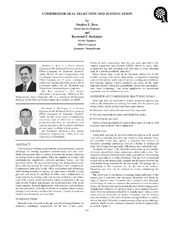| dc.contributor.other | Turbomachinery Symposium (32nd : 2003) | |
| dc.creator | Ross, Stephen L. | |
| dc.creator | Beckinger, Raymond F. | |
| dc.date.accessioned | 2017-10-04T23:47:46Z | |
| dc.date.available | 2017-10-04T23:47:46Z | |
| dc.date.issued | 2003 | |
| dc.identifier.uri | https://hdl.handle.net/1969.1/163285 | |
| dc.description | Tutorial | en |
| dc.description | pg. 167-178 | en |
| dc.description.abstract | The sealing of rotating equipment has always presented a special challenge for rotating equipment manufacturers and end users. Shaft seals are provided to restrict or prevent the escape of process or sealing fluids to atmosphere. They are required to comply with environmental regulations, prevent monetary losses, and for personnel safety. Dry gas seal technology has demonstrated reliability and cost savings for most applications of new compressors. Compressors built prior to the 1980s used earlier seal technology with varying amounts of success. In some cases a retrofit to a dry gas seal can easily be justified. In other cases, maintenance or improvements to existing seals can increase reliability and reduce costs with a lower initial investment when compared to a dry gas seal retrofit. Typical seas designs are reviewed along with recent improvements. Several applications with common seal problems are also presented. A listing of factors to consider when contemplating a seal retrofit is included for reference. Finally several case studies of seal retrofits are described. | en |
| dc.format.medium | Electronic | en |
| dc.format.mimetype | application/pdf | |
| dc.language.iso | en | |
| dc.publisher | Texas A&M University. Turbomachinery Laboratories | |
| dc.relation.ispartof | Proceedings of the 32nd Turbomachinery Symposium | en |
| dc.subject.lcsh | Turbomachines | en |
| dc.title | Compressor Seal Selection And Justification. | en |
| dc.type.genre | Presentation | en |
| dc.type.material | Text | en |
| dc.identifier.doi | https://doi.org/10.21423/R14944 | |


